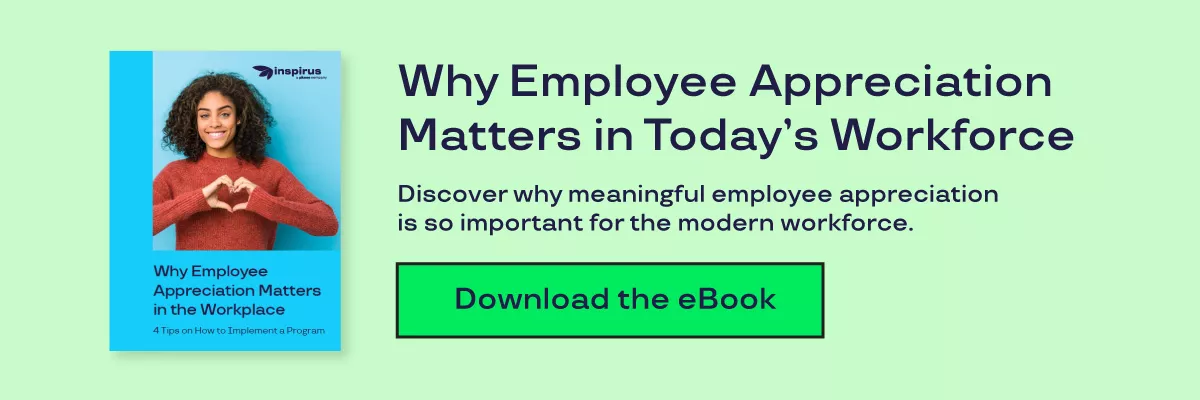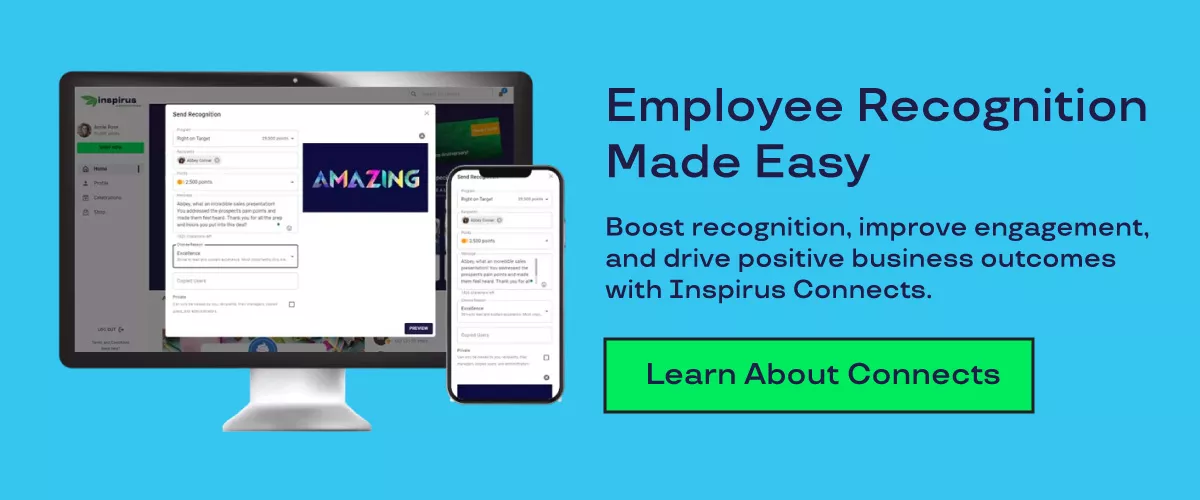
Boost Engagement with an Effective Employee Rewards and Recognition Program
May 1, 2024
Keep your team engaged and satisfied with a robust employee rewards and recognition program. Recognize the moments that matter most in the employee experience to boost engagement, retention, and more.
Studies show that many organizations are facing challenges with keeping their employees engaged since the COVID-19 pandemic. A recent study by Gallup reports that "employee engagement in the U.S. has dropped to its lowest level in more than a decade." Their research indicates only 30% of employees are engaged in 2024 -- a big drop from 36% in 2020.
Fortunately, there are tools and strategies readily available for HR professionals to combat this, one of which being an employee rewards and recognition program.
What is an Employee Rewards and Recognition Program?
An employee rewards and recognition program is a program designed to acknowledge and incentivize the achievements and behaviors of individuals within an organization. These programs are often used to elevate the employee experience and reward behaviors and contributions that positively impact an organization's success. That could include recognizing specific achievements, values-aligned behaviors, or even work anniversaries.
Organizations that see the most success with this type of program often incorporate both employee rewards and recognition. Although the two terms are closely related, there are a couple of differences between the two.
- Employee rewards are primarily used to reward employee performance, behavior, or milestones with tangible incentives. This can include gifts, bonuses, or time off.
- Employee recognition, on the other hand, focuses on acknowledging and appreciating employees for their efforts and contributions, often through verbal or written praise and acknowledgment.
Together, employee rewards and recognition can empower HR professionals and organizations to combat challenges in employee disengagement, turnover, organizational culture, team morale, productivity, and absenteeism.
Types of Employee Rewards and Recognition Programs
Employee rewards and recognition programs can be broadly categorized into two main types: social recognition programs and monetary programs. Here are the differences between the two.
Social Recognition
Social recognition programs empower employers to acknowledge and appreciate employees through gestures like verbal praise, peer-to-peer recognition, and awards ceremonies. This is type of program is non-monetary and relies on peers or superiors to distribute meaningful recognition. A social recognition program is a great option for connecting dispersed employees, strengthening employee relationships, and building a community for your organization.
Types of social recognition include:
- Peer-to-peer recognition
- Manager-to-employee recognition
- Team-based recognition
- Performance-based recognition
Monetary Recognition
Monetary reward programs, on the other hand, involve tangible rewards such as points, bonuses, gift cards, salary increases, or profit sharing. For instance, Inspirus’ points-based recognition platform, Connects Plus, offers an easy way to distribute rewards and encourage peer-to-peer recognition. A monetary rewards and recognition program is a great way to incentivize and reward high performance, behaviors aligned with core values, and general attitude. These programs can have significant benefits, including motivating employees to strive for excellence and fostering a positive workplace culture.
Types of monetary recognition include:
- Service anniversary rewards
- Employee milestone celebrations
- Special occasion recognition (i.e. holidays, birthdays, Employee Appreciation Day, etc.)
- Points-based recognition programs
- Nomination programs (i.e. presidents club, pinnacle of excellence, etc.)
Employee Rewards Examples
Employee rewards are an effective method for motivating and rewarding employees for their contributions and dedication to your organization. But like most things, employee rewards aren't without its challenges. A common issue organizations run into with an employee reward program is finding rewards that are truly valuable to employees. That's why it's important that program administrators must understand what types of rewards their staff find desirable and prefer.
Fortunately, the Incentive Research Foundation (IRF) recently conducted a survey to uncover which types of incentives each generation prefers the most. For the survey, IRF grouped participants into three groups -- early career, mid career, and late career -- to understand each generations preferences. Here are a few key findings from the research:
- Cash and gift cards were the most preferred incentives for rewards over $500 across all age groups and income levels.
- Younger workers are significantly more drawn to merchandise and experiences than mid-career and late-career workers.
- Gift cards were selected in the top three reward preferences for most respondents.
If you are unsure what rewards your staff would like, one great way to find out which they prefer is by sending out a company-wide survey with a list of options, like the ones shown below.
Here are a few examples of rewards that your team may appreciate receiving:
Gift Cards
Gift cards are a versatile and highly appreciated reward choice for employees. They provide recipients with the flexibility to choose their preferred reward, whether it's a dinner at their favorite restaurant, a shopping spree, or a relaxing spa day. Gift cards cater to individual preferences, making them a great option for recognizing employees' unique tastes and interests.
Branded Company Merchandise
Branded company merchandise such as apparel, stationery, or tech gadgets serves as a tangible symbol of pride and belonging for employees. By receiving branded merchandise, employees can feel a sense of affiliation with their organization and even become walking ambassadors for the company's brand. Branded merchandise also fosters a sense of unity and camaraderie among employees, reinforcing their connection to the organization and promoting a positive workplace culture.
Points in a Recognition Software
Points-based recognition programs offer employees the opportunity to accumulate points for their achievements and redeem them for various rewards. This system provides a structured and transparent way to acknowledge and reward employees for their efforts in one central location, fostering a culture of appreciation and recognition within the organization. Plus, points-based programs -- like Inspirus Connects Plus -- provide employees with flexible reward choices, as employees can select rewards that align with their preferences and interests, ultimately enhancing their motivation and engagement.
Time Off
Time off is a widely sought-after benefit -- and a great option for encouraging work-life balance and employee well-being. Whether it's an extra day of vacation, a wellness day, or a flexible work schedule, time off allows employees to recharge and rejuvenate, reducing burnout and improving overall job satisfaction. Offering time off as a reward demonstrates that the organization values employees' health and happiness, minimizing turnover costs in the long run.
Tickets and Events
As organizations continue to prioritize employee wellbeing, both inside and outside of the office, a great reward option that can improve employees’ wellbeing is offering tickets, events, or experiences as a reward. Tickets to events such as concerts, sports games, or theater performances provide employees with memorable experiences and opportunities for relaxation and enjoyment outside of work. By attending these events or even having the opportunity to travel, employees can take a break from their daily routine and create lasting memories that enhance their overall job satisfaction and engagement.
Each of these rewards could be a great choice for acknowledging and appreciating your employees’ contributions. By offering your staff rewards they truly value, you can enhance their employee experience, which, in turn, will boost their engagement and job satisfaction.

Why Is Employee Rewards and Recognition Important?
Employee rewards programs play a pivotal role in cultivating a culture of recognition and engagement within the workplace. Employees thrive when they are recognized for their contributions. And programs dedicated to recognition can have a big influence on an organization’s culture, performance, and results.
By acknowledging and rewarding employees for their hard work and dedication, these programs can drive tangible business results:
- Improved engagement and performance: Employee rewards and recognition programs are powerful tools for boosting employee engagement and performance. And the data doesn’t lie: A study by Deloitte found that recognition can boost engagement, productivity, and performance by 14%.
- Boosted employee morale and happiness: Recognition and appreciation are essential for creating a work environment where employees feel happy and thrive.
- Stronger sense of belonging: Recognizing employees for their achievements, they feel a sense of validation and connection to their team and organization.
- Improved retention: Employee turnover can be costly and disruptive to organizations. You can combat this by rewarding your staff for their contributions and years of service -- making them feel valued and more committed to your organization. In fact, recognized employees are nearly six times less likely to for a job elsewhere compared to their counterparts.
Employee rewards and recognition programs can help organizations foster a culture of appreciation within the workplace. By making their employees feel valued and appreciated, organizations can increase morale, instill a sense of pride in employees' work, and create a more positive work environment that motivates individuals to give their best effort.
How to Set up a Rewards and Recognition Program for Your Employees
Creating an effective employee rewards program requires careful planning and consideration. Here are five steps to follow when setting up a new program or even revising an existing program:
1. Define Objectives
The first step in setting up your rewards and recognition program is outlining the goals and objectives you want to achieve through it. When defining the objectives of your rewards program, consider your organization's overarching goals and how the program aligns with them.. Ask yourself what specific outcomes you hope to achieve through the program, whether it's boosting employee engagement, improving employee performance, or supporting your organization’s core values.
Once you've identified your objectives, clearly articulate them in writing, ensuring they are specific, measurable, achievable, relevant, and time-bound (SMART). This will help you outline a clear roadmap for the design and implementation of your rewards program and help keep it aligned with your organizational goals.
A few questions to consider at this stage: What do you want to achieve from the program? Are there organizational or departmental goals you want to support? How can this program support your organization's and teams' goals?
2. Select Recognition Methods and Establish Criteria
Once you’ve outlined your program's goals, you’ll need to determine the best approach for your reward and recognition program. Determine how much of your budget you will allocate to recognition and rewards (you can calculate your costs with our budget calculator!). Consider which type of recognition and reward programs will best support your objectives and goals for the program.
Another key step is establishing clear criteria and benchmarks for earning rewards and recognition. This essential step will help make your program inclusive and fair. Whether based on individual performance, team achievements, or organizational milestones, the criteria should be objective, measurable, and easily understandable by all employees. If you decide to use a points-based recognition system, determine how many points you will allocate for each job level and whether you will allocate points monthly or annually.
Make sure to work closely with key stakeholders, such as HR managers and leaders, to develop the criteria and metrics for earning rewards. Depending on the specific goals of your rewards program, consider factors such as productivity, quality of work, teamwork, innovation, and customer satisfaction.
A few questions to consider at this stage: Are you going to use a monetary or non-monetary program? Which type of recognition and rewards program would best support your objectives? Are there certain behaviors, achievements, etc. you would like to reward? What KPIs can you measure and benchmark?
3. Determine Reward Selection
When you’ve solidified the recognition methods, you’ll need to select the reward options for your program(s). When selecting rewards for your program, it's important to offer diverse options that cater to your employees' varying preferences and motivations. Consider both monetary and non-monetary incentives, as different individuals may be motivated by different types of rewards.
In addition, take into account your organizational values and culture when choosing rewards. Ensure that they reflect the ethos of your company and are aligned with the behaviors and achievements you wish to promote.
4. Implement Your Program
Now that you have your reward and recognition program set up, it’s time to launch it! Rolling out your rewards program requires careful planning and coordination. Provide necessary resources and support for its implementation, including training for managers and employees on how the program works and what is of them.
Ensure you have a plan for communicating the program to your employees. During the launch, provide your staff with documentation on how to access the rewards and recognition and what to expect from the program. Consider sharing this information across multiple channels to make all employees aware of the new program.
5. Monitor and Adjust
Congratulations! You have successfully launched your program. Now that it is live, you'll need to monitor and adjust it as needed. Remember, don't set and forget your program! Continually remind employees about it — share tips, tricks, and best practices often to help boost participation.
Be sure to monitor the program's effectiveness regularly, gathering feedback from employees through employee surveys. Track key metrics such as employee engagement levels, productivity, retention rates, and the frequency of reward distributions to assess the program's impact.
Based on the feedback and evaluation results, adjust the program as needed to ensure it meets your staff's needs and expectations and supports your organization's overarching goals. Celebrate successes and highlight achievements along the way to reinforce a culture of appreciation and recognition within your workplace.
Best Practices for an Effective Employee Rewards Program
If you want to make the most out of your employee rewards program, here are four key best practices to consider when designing and managing the program:
Tie the Program to Your Core Values
Your rewards and recognition program should reinforce the organization's core values. By tying the program criteria to the core values, you can reinforce these desired behaviors and foster a values-driven workplace.
For example, if one of your core values is innovation, recognize employees who come up with creative solutions to challenges or contribute ideas that drive business growth. Employees who see a direct connection between their actions and the organization's values will be more likely to feel motivated and engaged by the program.
Encourage Peer Recognition
Encouraging peer-to-peer recognition empowers employees to appreciate and acknowledge each other's contributions, fostering a culture of appreciation and teamwork within the organization. Provide opportunities for employees to give and receive recognition from their colleagues through platforms such as recognition software, team meetings, or dedicated appreciation channels.
Peer recognition not only strengthens relationships and collaboration among team members but also distributes recognition more evenly across the organization, ensuring that all employees feel valued and appreciated for their efforts. If you have a dispersed workforce, promoting peer recognition can empower your employees to create deeper connections, which in turn, will foster better collaboration and higher engagement.
By encouraging peer recognition, you can empower your staff to play an active role in shaping the organization's culture and fostering a positive work environment.
Offer Rewards Employees Know and Love
As previously mentioned, when selecting rewards for your program, it's essential to offer options that resonate with your employees and align with their preferences and interests. Conduct surveys or focus groups to gather insights into what types of rewards employees value most, whether it's gift cards, extra time off, or opportunities for professional development.
Providing rewards that employees know and love not only increases their motivation to participate in the program but also enhances their overall satisfaction and engagement with their work. Additionally, offering a variety of rewards ensures that you can cater to diverse preferences and motivations within your workforce.
Communicate Frequently
Effective communication is key to the success of any rewards and recognition program. Keep employees informed about the program's goals, criteria, and rewards through regular communication channels such as email, team meetings, or intranet updates. Be transparent about how the program works and what is expected of employees, ensuring that everyone understands the process for earning rewards and recognition.
Additionally, celebrate successes and share stories of employees who have been recognized for their contributions, reinforcing the program's value and encouraging continued participation. Communicate frequently and transparently to demonstrate your organization's commitment to recognizing and appreciating employees' efforts.
Streamline Rewards and Recognition with Inspirus
Setting up an employee rewards and recognition program is vital to creating an thriving and engaged workplace. In today's modern workforce, it plays an important role in keeping employees engaged, satisfied, and productivity. And while it may seem like a daunting task to set one up, it doesn't have to be.
At Inspirus, we can help you reduce the burden of implementing and managing a manual employee rewards and recognition program. With our all-in-one employee recognition and engagement solution, Inspirus Connects, we can help you streamline the distribution of employee rewards and foster a company-wide culture of appreciation.
With over 130 years of experience, our team of specialists will partner with you to create a tailored rewards and recognition strategy that meets your organization's unique needs. Talk with one of our specialists to see how we can help you!





